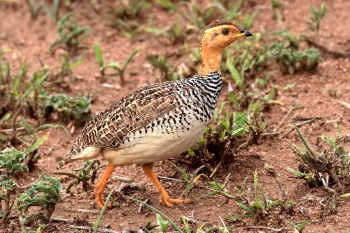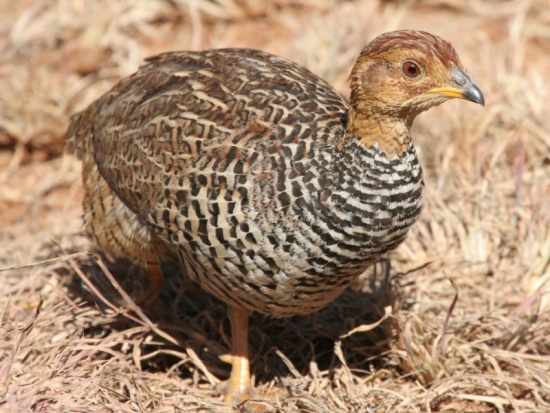- Campocolinus coqui
Peliperdix coqui
Identification

Photo © by nick scarle
Serengeti NP, Tanzania, November 2017
Length 20-28 cm (7¾-11 in), mass 191-314 g.
Bill black and legs yellow
Adult male:
The head, upper neck and throat are plain mustard yellow, and the lower neck, breast and mantle are barred black and white. The belly is barred black on cream. The back is brown with pale streaks and black blotches.
Adult female:
Has a pale eyebrow and throat and plain buffy breast.
Distribution
Sub-Saharan Africa: Senegal and southern Ethiopia to north-eastern South Africa .
Taxonomy
This is a polytypic species[1] consisting of 4 subspecies.
Formerly placed in genus Francolinus.
Subspecies

Photo © by nick scarle
Serengeti NP, Tanzania, November 2017
- C. c. spinetorum
- C. c. maharao
Ethiopia to southern Uganda, Kenya and northern Tanzania
- C. c. hubbardi
Western and southern Kenya to central Tanzania
- C. c. coqui
DRC-Democratic Republic of the Congo to central and northwestern Tanzania, and south to northern Namibia, Botswana, and eastern South Africa (south to KwaZulu-Natal)
Habitat
Woodland and savanna; especially those with sandy soils.
Behaviour
A shy bird, it freezes when alarmed, thus making it less likely to be flushed from cover. It is found in pairs. A sedentary bird, it only flies under extreme pressure.
Diet
The diet includes seeds, grass or grain, and small insects.
References
- Clements, J. F., T. S. Schulenberg, M. J. Iliff, S. M. Billerman, T. A. Fredericks, J. A. Gerbracht, D. Lepage, B. L. Sullivan, and C. L. Wood. 2021. The eBird/Clements checklist of Birds of the World: v2021. Downloaded from https://www.birds.cornell.edu/clementschecklist/download/
- Dickinson, EC, ed. 2003. The Howard and Moore Complete Checklist of the Birds of the World. 3rd ed., with updates to December 2007 (Corrigenda 7). Princeton: Princeton Univ. Press. ISBN 978-0691117010
- Hockey, PAR, WRJ Dean, and PG Ryan, eds. 2005. Roberts' Birds of Southern Africa. 7th ed. Cape Town: John Voelcker Bird Book Fund. ISBN 978-0620340533
- Sibley, CG and BL Monroe. 1996. Birds of the World, on diskette, Windows version 2.0. Charles G. Sibley, Santa Rosa, CA, USA.
- Sinclair, I and P Ryan. 2003. Birds of Africa South of the Sahara. Princeton: Princeton Univ. Press. ISBN 978-0691118154
Recommended Citation
- BirdForum Opus contributors. (2024) Coqui Francolin. In: BirdForum, the forum for wild birds and birding. Retrieved 28 April 2024 from https://www.birdforum.net/opus/Coqui_Francolin
External Links
GSearch checked for 2020 platform.




